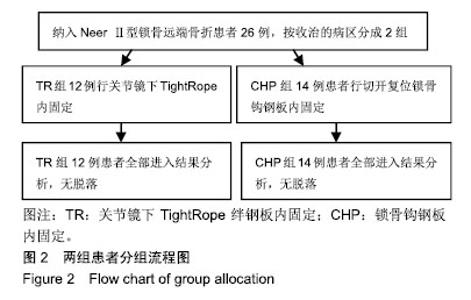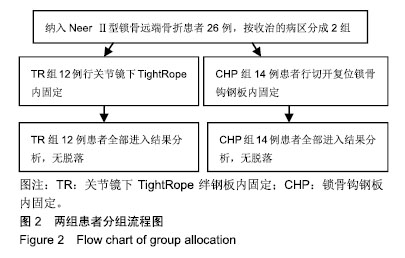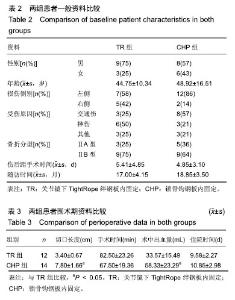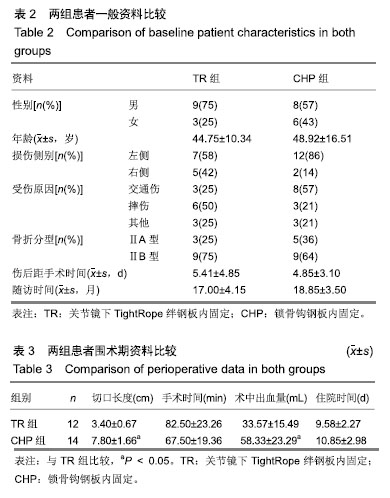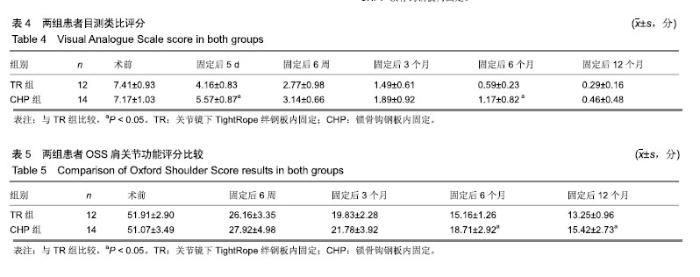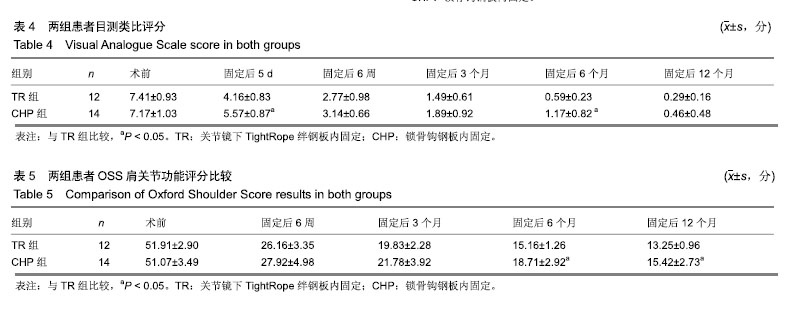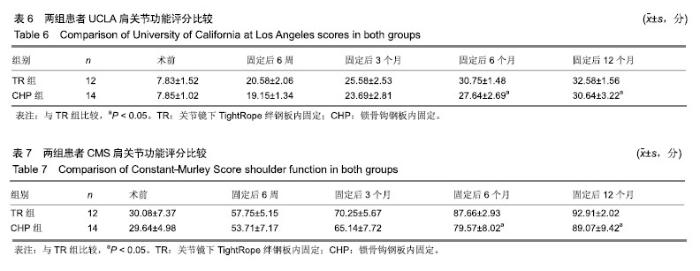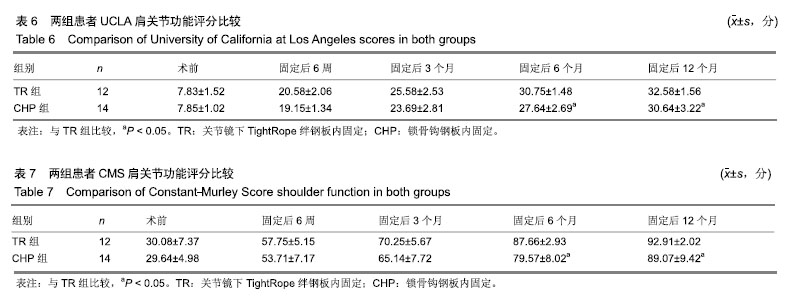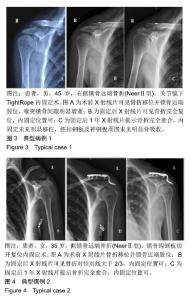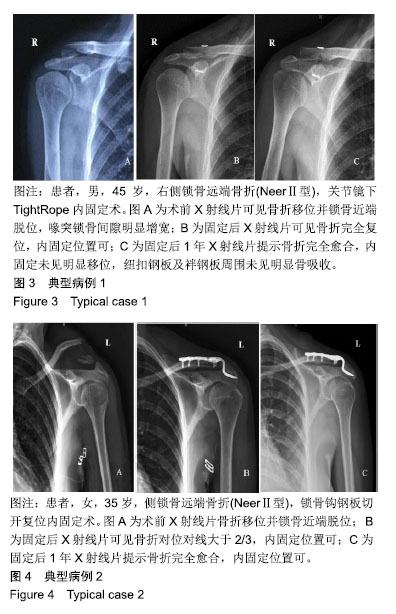Chinese Journal of Tissue Engineering Research ›› 2019, Vol. 23 ›› Issue (32): 5117-5125.doi: 10.3969/j.issn.2095-4344.1495
Previous Articles Next Articles
TightRope system versus clavicular hook plate in the treatment of Neer type II distal clavicle fractures using arthroscopy
Wu Cheng1, Xia Yaqing2, Wang Jianji1, Liu Riguang1, Fan Jiannan1
- 1Department of Sports Medicine, the Affiliated Hospital of Guizhou Medical University, Guiyang 550004, Guizhou Province, China; 2Department of Orthopedics, Dafeng People’s Hospital, Yancheng 224100, Jiangsu Province, China
-
Online:2019-11-18Published:2019-11-18 -
Contact:Fan Jiannan, Chief physician, Master’s supervisor, Department of Sports Medicine, the Affiliated Hospital of Guizhou Medical University, Guiyang 550004, Guizhou Province, China -
About author:Wu Cheng, Master, Attending physician, Department of Sports Medicine, the Affiliated Hospital of Guizhou Medical University, Guiyang 550004, Guizhou Province, China -
Supported by:the Funded Project of Guiyang Science and Technology Bureau, No. QKHCG[2018]4613-7 (to WC)
CLC Number:
Cite this article
Wu Cheng, Xia Yaqing, Wang Jianji, Liu Riguang, Fan Jiannan. TightRope system versus clavicular hook plate in the treatment of Neer type II distal clavicle fractures using arthroscopy[J]. Chinese Journal of Tissue Engineering Research, 2019, 23(32): 5117-5125.
share this article
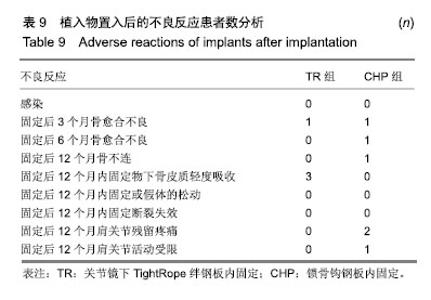
2.8 不良反应 在随访期间均未出现肩锁关节脱位、应力性骨折、内固定物断裂、松动及切口感染等主要不良反应。CHP组中1例患者固定后3,6,12个月影像学提示骨愈合不良、骨不连。固定后12个月,2例患者有明显肩部疼痛,1例患者有明显肩关节外展活动受限,于去除内固定后经随访均有不同程度缓解。TR组中有1例患者于固定后3个月复查提示有骨折端的愈合欠佳,患肩继续肩关节支具制动,固定后6个月复查示骨折愈合良好,无疼痛,活动良好。TR组固定后12个月随访中发现有3例患者出现了锁骨端钢板下轻度骨皮质吸收和钢板下陷,但无复位丢失和临床症状,因此未计入不良反应。不良反应发生率TR组为8.3%(1/12),CHP组28.6% (4/14),两组比较无显著性意义(P > 0.05)。植入物置入后的不良反应见表9。"
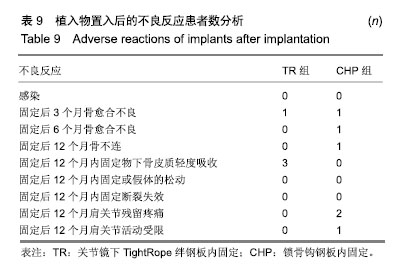
| [1]Sambandam B, Gupta R, Kumar S, et al. Fracture of distal end clavicle: a review. J Clin Orthop Trauma. 2014;5(2):65-73. [2]Oh JH, Kim SH, Lee JH, et al. Treatment of distal clavicle fracture: a systematic review of treatment modalities in 425 fractures. Arch Orthop Trauma Surg. 2011;131(4):525-533. [3]Takase K, Kono R, Yamamoto K. Arthroscopic stabilization for Neer type 2 fracture of the distal clavicle fracture. Arch Orthop Trauma Surg. 2012;132(3):399-403. [4]Motta P, Bruno L, Maderni A, et al. Acute lateral dislocated clavicular fractures: arthroscopic stabilization with TightRope. J Shoulder Elbow Surg. 2014;23(3):e47-e52. [5]陈建海,党育,付中国,等.关节镜下纽扣钢板固定术治疗不稳定锁骨远端骨折[J].中华肩肘外科电子杂志,2015,3(3):133-140. [6]NEER CS 2nd. Fracture of the distal clavicle with detachment of the coracoclavicular ligaments in adults. J Trauma. 1963;3: 99-110. [7]Preedy VR, Watson RR. Visual Analogue Scale. Handbook of Disease Burdens and Quality of Life Measures. New York: Springer, USA. 2010:4349-4349. [8]Dawson J, Fitzpatrick R, Carr A. Questionnaire on the perceptions of patients about shoulder surgery. J Bone Joint Surg Br. 1996;78(4):593-600. [9]Ellman H, Hanker G, Bayer M. Repair of the rotator cuff. End-result study of factors influencing reconstruction. J Bone Joint Surg Am. 1986;68(8):1136-1144. [10]Constant CR, Murley AH. A clinical method of functional assessment of the shoulder. Clin Orthop Relat Res.1987;(214): 160-164. [11]王志强,栗树伟,王东.Neer Ⅱ型锁骨远端骨折的治疗进展[J].中华肩肘外科电子杂志,2017,5(2):138-141. [12]Li Q, Hsueh PL, Chen YF. Coracoclavicular ligament reconstruction: a systematic review and a biomechanical study of a triple endobutton technique. Medicine (Baltimore). 2014; 93(28):e193. [13]Teodoro Ezequiel Guerra M, Isabel Pozzi M, Busin G, et al. Densitometric study of the clavicle: bone mineral density explains the laterality of the fractures. Rev Bras Ortop. 2014; 49(5):468-472. [14]汪鹏,董宏然.锁骨远端骨折的治疗进展[J].中国矫形外科志,2014, 22(22):2071-2074. [15]Bishop JY, Jones GL, Lewis B, et al. Intra- and interobserver agreement in the classification and treatment of distal third clavicle fractures. Am J Sports Med. 2015;43(4):979-984. [16]谭虎成,马海涛,毕大卫,等.12例NeerⅡ型锁骨远端骨折内固定失效原因分析[J].中国骨与关节损伤杂志,2014,29(9):940-941.[17]江涛,苏海涛,朱兴阳,等.NeerⅡ锁骨远端骨折的治疗(英文)[J].中国矫形外科杂志,2014,22(20):1825-1830. [18]齐双,夏茂盛.锁骨钩钢板和锁骨远端锁定钢板内固定治疗NeerⅡ型锁骨远端骨折术后不良反应和功能恢复的Meta分析[J].中国骨与关节损伤杂志,2016,31(7):715-717. [19]朱小广,彭庆州,吴宏伟.带线锚钉与锁骨钩板内固定治疗NeerⅡ型锁骨远端骨折的疗效比较[J].中国骨与关节损伤杂志, 2016, 31(5):535-536.[20]胡晓川,林辉阳,向明,等.锁定钢板结合缝合锚固定治疗Neer ⅡB型锁骨远端骨折[J].中华肩肘外科电子杂志,2015,3(4):199-205. [21]Seyhan M, Kocaoglu B, Kiyak G, et al. Anatomic locking plate and coracoclavicular stabilization with suture endo-button technique is superior in the treatment of Neer Type II distal clavicle fractures. Eur J Orthop Surg Traumatol. 2015; 25(5): 827-832. [22]Shin SJ, Ko YW, Lee J, et al. Use of plate fixation without coracoclavicular ligament augmentation for unstable distal clavicle fractures. J Shoulder Elbow Surg. 2016;25(6):942-948. [23]Madsen W, Yaseen Z, LaFrance R, et al. Addition of a suture anchor for coracoclavicular fixation to a superior locking plate improves stability of type IIB distal clavicle fractures. Arthroscopy. 2013;29(6):998-1004. [24]Struhl S, Wolfson TS. Continuous loop double endobutton reconstruction for acromioclavicular joint dislocation. Am J Sports Med. 2015;43(10):2437-2444. [25]Dedeo?lu SS, ?mren Y, Çabuk H, et al. Results of minimal invasive coracoclavicular fixation by double button lift-up system in Neer type II distal clavicle fractures. J Orthop Surg (Hong Kong). 2017. [26]]梁高峰,智丰,张满盈,等.双Endobutton双环套锁内固定术治疗Tossy Ⅲ型肩锁关节脱位及Neer ⅡB型锁骨远端骨折[J].中国修复重建外科杂志,2014,28(3):395-396. [27]Costic RS, Vangura A Jr, Fenwick JA, et al. Viscoelastic behavior and structural properties of the coracoclavicular ligaments. Scand J Med Sci Sports. 2003;13(5):305-310. [28]Soh C, Sivapathasundaram N, Parthiban R, et al. A technique of distal clavicle fracture fixation using the tightrope procedure. Malays Orthop J. 2011;5(3):20-23. [29]Kraus N, Stein V, Gerhardt C, et al. Arthroscopically assisted stabilization of displaced lateral clavicle fractures with coracoclavicular instability. Arch Orthop Trauma Surg. 2015; 135(9):1283-1290. [30]Loriaut P, Moreau PE, Dallaudière B, et al. Outcome of arthroscopic treatment for displaced lateral clavicle fractures using a double button device. Knee Surg Sports Traumatol Arthrosc. 2015;23(5):1429-1433. [31]Tischer T, Salzmann GM, El-Azab H, et al. Incidence of associated injuries with acute acromioclavicular joint dislocations types III through V. Am J Sports Med. 2009;37(1): 136-139. [32]Cano-Martínez JA, Nicolás-Serrano G, Andrés-Grau J, et al. Treatment of distal-third clavicular fractures (Neer type ii-b) with a triple button device. Rev Esp Cir Ortop Traumatol. 2016; 60(6):378-386. [33]Beitzel K, Obopilwe E, Chowaniec DM, et al. Biomechanical comparison of arthroscopic repairs for acromioclavicular joint instability: suture button systems without biological augmentation. Am J Sports Med. 2011;39(10):2218-2225. [34]Salzmann GM, Paul J, Sandmann GH, et al. The coracoidal insertion of the coracoclavicular ligaments: an anatomic study. Am J Sports Med. 2008;36(12):2392-2397. [35]Yi Y, Kim JW. Coronal plane radiographic evaluation of the single TightRope technique in the treatment of acute acromioclavicular joint injury. J Shoulder Elbow Surg. 2015; 24(10):1582-1587. |
| [1] | Hu Kai, Qiao Xiaohong, Zhang Yonghong, Wang Dong, Qin Sihe. Treatment of displaced intra-articular calcaneal fractures with cannulated screws and plates: a meta-analysis of 15 randomized controlled trials [J]. Chinese Journal of Tissue Engineering Research, 2021, 25(9): 1465-1470. |
| [2] | Xu Feng, Kang Hui, Wei Tanjun, Xi Jintao. Biomechanical analysis of different fixation methods of pedicle screws for thoracolumbar fracture [J]. Chinese Journal of Tissue Engineering Research, 2021, 25(9): 1313-1317. |
| [3] | Zhang Tongtong, Wang Zhonghua, Wen Jie, Song Yuxin, Liu Lin. Application of three-dimensional printing model in surgical resection and reconstruction of cervical tumor [J]. Chinese Journal of Tissue Engineering Research, 2021, 25(9): 1335-1339. |
| [4] | Du Xiupeng, Yang Zhaohui. Effect of degree of initial deformity of impacted femoral neck fractures under 65 years of age on femoral neck shortening [J]. Chinese Journal of Tissue Engineering Research, 2021, 25(9): 1410-1416. |
| [5] | Zhang Shangpu, Ju Xiaodong, Song Hengyi, Dong Zhi, Wang Chen, Sun Guodong. Arthroscopic suture bridge technique with suture anchor in the treatment of acromioclavicular dislocation [J]. Chinese Journal of Tissue Engineering Research, 2021, 25(9): 1417-1422. |
| [6] | Zhou Jihui, Li Xinzhi, Zhou You, Huang Wei, Chen Wenyao. Multiple problems in the selection of implants for patellar fracture [J]. Chinese Journal of Tissue Engineering Research, 2021, 25(9): 1440-1445. |
| [7] | Chen Junming, Yue Chen, He Peilin, Zhang Juntao, Sun Moyuan, Liu Youwen. Hip arthroplasty versus proximal femoral nail antirotation for intertrochanteric fractures in older adults: a meta-analysis [J]. Chinese Journal of Tissue Engineering Research, 2021, 25(9): 1452-1457. |
| [8] | Wang Xianyao, Guan Yalin, Liu Zhongshan. Strategies for improving the therapeutic efficacy of mesenchymal stem cells in the treatment of nonhealing wounds [J]. Chinese Journal of Tissue Engineering Research, 2021, 25(7): 1081-1087. |
| [9] | Zhong Hehe, Sun Pengpeng, Sang Peng, Wu Shuhong, Liu Yi. Evaluation of knee stability after simulated reconstruction of the core ligament of the posterolateral complex [J]. Chinese Journal of Tissue Engineering Research, 2021, 25(6): 821-825. |
| [10] | Xu Yulin, Shen Shi, Zhuo Naiqiang, Yang Huilin, Yang Chao, Li Yang, Zhao Heng, Zhao Lu. Biomechanical comparison of three different plate fixation methods for acetabular posterior column fractures in standing and sitting positions [J]. Chinese Journal of Tissue Engineering Research, 2021, 25(6): 826-830. |
| [11] | Hou Guangyuan, Zhang Jixue, Zhang Zhijun, Meng Xianghui, Duan Wen, Gao Weilu. Bone cement pedicle screw fixation and fusion in the treatment of degenerative spinal disease with osteoporosis: one-year follow-up [J]. Chinese Journal of Tissue Engineering Research, 2021, 25(6): 878-883. |
| [12] | He Li, Tian Wei, Xu Song, Zhao Xiaoyu, Miao Jun, Jia Jian. Factors influencing the efficacy of lumbopelvic internal fixation in the treatment of traumatic spinopelvic dissociation [J]. Chinese Journal of Tissue Engineering Research, 2021, 25(6): 884-889. |
| [13] | Yang Weiqiang, Ding Tong, Yang Weike, Jiang Zhengang. Combined variable stress plate internal fixation affects changes of bone histiocyte function and bone mineral density at the fractured end of goat femur [J]. Chinese Journal of Tissue Engineering Research, 2021, 25(6): 890-894. |
| [14] | Zhang Lei, Ma Li, Fu Shijie, Zhou Xin, Yu Lin, Guo Xiaoguang. Arthroscopic treatment of greater tuberosity avulsion fractures with anterior shoulder dislocation using the double-row suture anchor technique [J]. Chinese Journal of Tissue Engineering Research, 2021, 25(6): 895-900. |
| [15] | Yuan Xinping, Shao Yanbo, Wu Chao, Wang Jianling, Tong Liangcheng, Li Ying. Accuracy of target bone segments in personalized differential modeling and simulation of CT scanning parameters at fracture end [J]. Chinese Journal of Tissue Engineering Research, 2021, 25(6): 912-916. |
| Viewed | ||||||
|
Full text |
|
|||||
|
Abstract |
|
|||||
